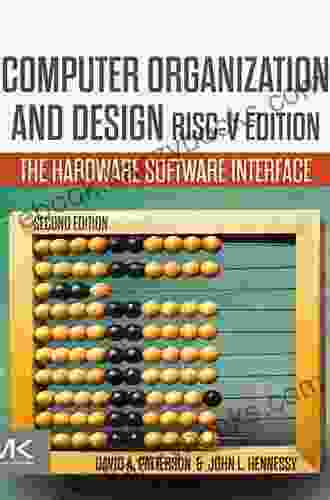The Hardware-Software Interface: Unlocking the Secrets of Seamless Communication

In the realm of digital technology, the hardware-software interface (HSI) stands as the pivotal gateway that connects the physical components of a computer to the intangible world of software. It serves as the translator, enabling the two distinct realms to communicate seamlessly and orchestrate the symphony of modern computing. The International Standard Serial Number (ISSN) plays a pivotal role in this intricate dance, providing a unique identifier for serial publications, such as journals, magazines, and newspapers.
4.3 out of 5
| Language | : | English |
| File size | : | 359151 KB |
| Text-to-Speech | : | Enabled |
| Screen Reader | : | Supported |
| Enhanced typesetting | : | Enabled |
| Print length | : | 739 pages |
The Genesis and Evolution of ISSN
The concept of ISSN emerged in the early 1970s, as the publishing industry grappled with the need for a standardized system to identify and manage serial publications. Prior to this, each publication relied on its own unique identification number, leading to confusion and inefficiencies in cataloging and retrieval. Recognizing this pressing need, the International Organization for Standardization (ISO) embarked on a mission to develop a global, universally accepted standard.
In 1971, ISO 3297, the International Standard Serial Numbering (ISSN),was born. This groundbreaking standard established a framework for assigning unique eight-digit identifiers to serial publications, regardless of their country of origin or language. The ISSN revolutionized the world of serials management, providing a common language for libraries, publishers, and researchers to identify, catalog, and exchange information.
The Anatomy of an ISSN
Each ISSN is composed of eight digits, divided into two parts. The first seven digits represent the unique identifier assigned to the publication. The eighth digit, known as the check digit, serves as a safeguard against errors. It is calculated using a mathematical algorithm based on the first seven digits, ensuring the integrity of the ISSN and minimizing the risk of misidentification.
For instance, the ISSN for the renowned scientific journal "Nature" is 0028-0836. The first seven digits (0028-083) uniquely identify the publication, while the eighth digit (6) is the calculated check digit.
The Significance of ISSN
The ISSN has become an indispensable tool in the world of serial publications, serving a multitude of purposes:
- Unique Identification: ISSN provides a unique and unambiguous identifier for each serial publication, ensuring that different editions and volumes can be easily distinguished.
- Cataloging and Retrieval: Libraries, databases, and other institutions use ISSNs as a primary means of cataloging and retrieving serial publications. This enables efficient searching, access, and management of vast collections.
- Interlibrary Loan: ISSNs facilitate interlibrary loan services, allowing libraries to locate and borrow specific issues of serial publications from other institutions.
- Subscription Management: Publishers use ISSNs to manage subscriptions, track Free Downloads, and ensure timely delivery of publications to subscribers.
- Bibliographic Control: ISSNs play a crucial role in bibliographic control, providing a standard way to reference and cite serial publications in academic papers, research articles, and other scholarly works.
The HSI in Action
The HSI is a complex and dynamic system that involves a multitude of components, including:
- Computer Architecture: The hardware architecture of a computer system defines the physical structure and organization of its components, including the processor, memory, and input/output devices. It provides the foundation upon which the HSI is built.
- Operating Systems: Operating systems act as the intermediary between hardware and software, managing the allocation of resources and providing a platform for software applications to run. They play a critical role in facilitating communication between the hardware and software layers.
- Device Drivers: Device drivers are software programs that enable specific hardware devices, such as printers, scanners, and network cards, to communicate with the operating system and other software applications. They act as translators, converting high-level software commands into low-level hardware instructions.
- Application Software: Application software, such as word processors, spreadsheets, and web browsers, interacts with the HSI through system calls and other mechanisms provided by the operating system. These applications rely on the HSI to access hardware resources and perform specific tasks.
The HSI is not a static entity but rather a constantly evolving ecosystem, driven by advancements in hardware technology, the development of new software applications, and the emergence of novel operating systems. Each component of the HSI must work in harmony to ensure seamless communication and efficient operation of the overall computer system.
The hardware-software interface is the vital artery that connects the physical and digital worlds, enabling the seamless interaction between hardware components and software applications. ISSN, as a unique identifier for serial publications, plays a pivotal role in this intricate dance, providing a common language for managing and accessing information. By delving into the depths of the HSI and ISSN, we gain a profound appreciation for the complex interplay that underpins the very fabric of modern computing.
As technology continues to advance at an unprecedented pace, the HSI will undoubtedly face new challenges and opportunities. The ability to bridge the gap between hardware and software will remain paramount, ensuring that we continue to harness the full potential of digital devices and revolutionize the way we live, work, and interact with the world around us.
4.3 out of 5
| Language | : | English |
| File size | : | 359151 KB |
| Text-to-Speech | : | Enabled |
| Screen Reader | : | Supported |
| Enhanced typesetting | : | Enabled |
| Print length | : | 739 pages |
Do you want to contribute by writing guest posts on this blog?
Please contact us and send us a resume of previous articles that you have written.
 Book
Book Novel
Novel Page
Page Chapter
Chapter Text
Text Story
Story Genre
Genre Reader
Reader Library
Library Paperback
Paperback E-book
E-book Magazine
Magazine Newspaper
Newspaper Paragraph
Paragraph Sentence
Sentence Bookmark
Bookmark Shelf
Shelf Glossary
Glossary Bibliography
Bibliography Foreword
Foreword Preface
Preface Synopsis
Synopsis Annotation
Annotation Footnote
Footnote Manuscript
Manuscript Scroll
Scroll Codex
Codex Tome
Tome Bestseller
Bestseller Classics
Classics Library card
Library card Narrative
Narrative Biography
Biography Autobiography
Autobiography Memoir
Memoir Reference
Reference Encyclopedia
Encyclopedia Vickie Gould
Vickie Gould Vanessa Luther
Vanessa Luther Mastery Era Publishing
Mastery Era Publishing Ramaji
Ramaji Read Spear
Read Spear Michele A Livingston
Michele A Livingston Mr Bbq
Mr Bbq Peter D Jacobson
Peter D Jacobson Michelle Golden
Michelle Golden Mcfinn Lovere
Mcfinn Lovere Amy Bloom
Amy Bloom Rex Baker
Rex Baker Lauren Golis
Lauren Golis Neumann Heather
Neumann Heather Scott Mcelhaney
Scott Mcelhaney Kimiko
Kimiko Victoria Goode
Victoria Goode Tricia Hamilton
Tricia Hamilton Lucia Raatma
Lucia Raatma Iris Gottlieb
Iris Gottlieb
Light bulbAdvertise smarter! Our strategic ad space ensures maximum exposure. Reserve your spot today!

 Dale MitchellGlow Like Never Before: The Ultimate Guide to Banishing Acne and Scars with...
Dale MitchellGlow Like Never Before: The Ultimate Guide to Banishing Acne and Scars with...
 Clarence MitchellUnveiling the Timeless Wisdom of Lao Tzu: Journey into the Profound Teachings...
Clarence MitchellUnveiling the Timeless Wisdom of Lao Tzu: Journey into the Profound Teachings... Evan HayesFollow ·2.8k
Evan HayesFollow ·2.8k Darnell MitchellFollow ·12.8k
Darnell MitchellFollow ·12.8k Curtis StewartFollow ·11k
Curtis StewartFollow ·11k Glen PowellFollow ·8.1k
Glen PowellFollow ·8.1k Mario BenedettiFollow ·4.4k
Mario BenedettiFollow ·4.4k Truman CapoteFollow ·12k
Truman CapoteFollow ·12k Ian MitchellFollow ·16.4k
Ian MitchellFollow ·16.4k Carter HayesFollow ·3.7k
Carter HayesFollow ·3.7k

 Edward Reed
Edward ReedWhat Our Lungs Teach Us About Our Origins, Ourselves, and...
Our lungs, the unseen heroes of our existence,...

 Jonathan Hayes
Jonathan HayesFood Additives and Human Health: Unlocking the Secrets...
In the modern era,...

 Gabriel Garcia Marquez
Gabriel Garcia Marquez101 Grilled Seafood Recipes: Elevate Your Seafood...
Discover the Art...

 Javier Bell
Javier BellFundamentals of Applied Animal Nutrition: A Comprehensive...
Animal nutrition is a critical aspect of...

 Devon Mitchell
Devon MitchellUnleash Your Sweet Tooth: Dive into the Delightful World...
: Step into a Culinary Paradise Prepare to...

 Voltaire
VoltaireOver 50 Delicious Dishes Made With This Miracle...
Are you looking for new...
4.3 out of 5
| Language | : | English |
| File size | : | 359151 KB |
| Text-to-Speech | : | Enabled |
| Screen Reader | : | Supported |
| Enhanced typesetting | : | Enabled |
| Print length | : | 739 pages |








